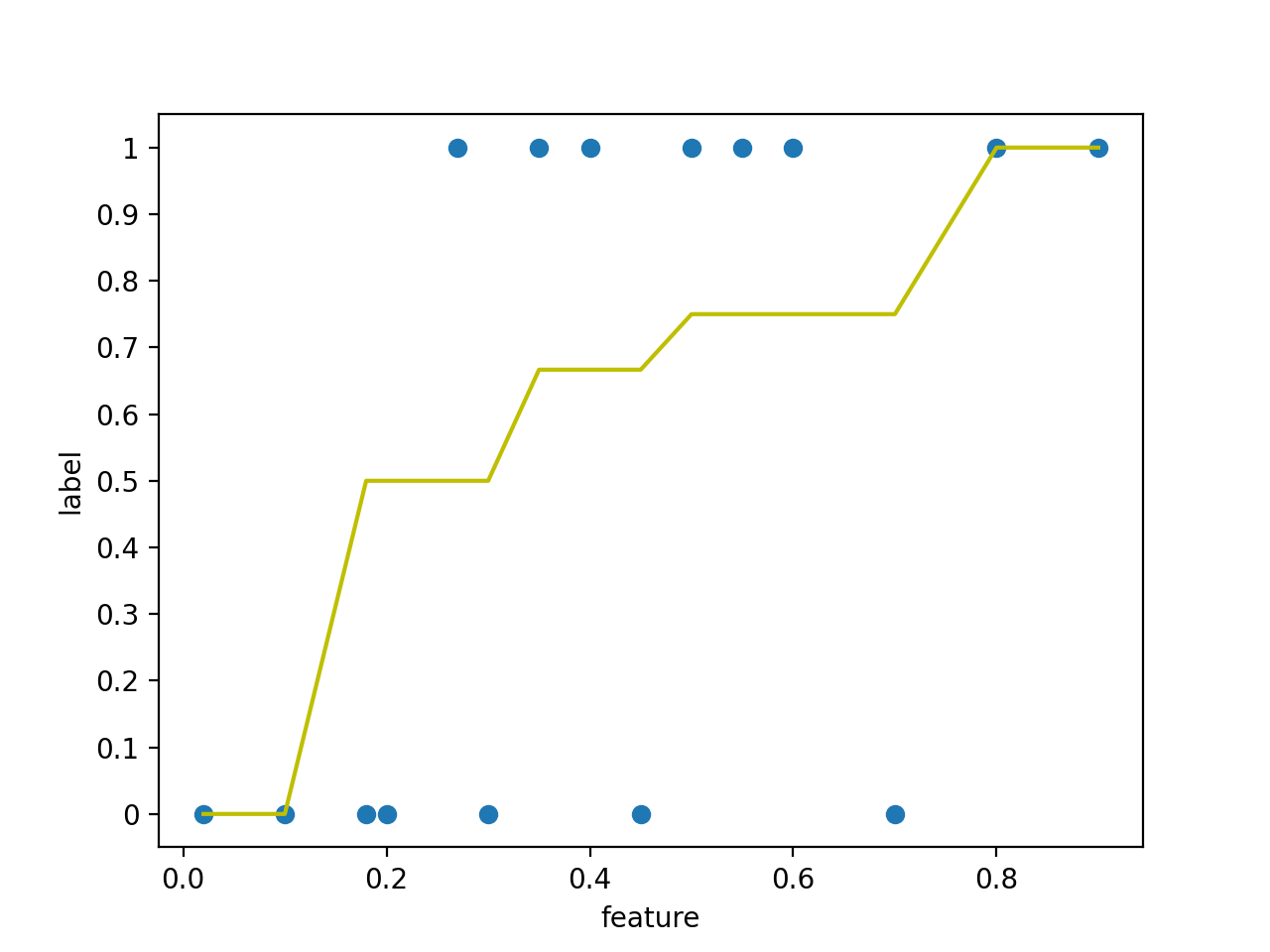Java 类名:com.alibaba.alink.pipeline.regression.IsotonicRegression
Python 类名:IsotonicRegression
功能介绍
保序回归在观念上是寻找一组非递减的片段连续线性函数(piecewise linear continuous functions),即保序函数,使其与样本尽可能的接近。
保序回归的输入在Alink中称分别为特征(feature)、标签(label)和权重(weight),特征可以是数值或向量,如果是向量还需要设定特征索引
(feature index),组件将使用该维进行计算。保序回归的目标是求解一个能使最小的序列,
若选择保增序,该序列还应满足时,若选择保降序满足时。
下图中,散点图是训练数据,折线图是得到的保序回归模型,对于训练数据中没有的特征,使用线性插值得到其标签。对应训练和预测代码见示例。

参数说明
| 名称 | 中文名称 | 描述 | 类型 | 是否必须? | 取值范围 | 默认值 |
|---|---|---|---|---|---|---|
| labelCol | 标签列名 | 输入表中的标签列名 | String | ✓ | ||
| predictionCol | 预测结果列名 | 预测结果列名 | String | ✓ | ||
| featureCol | 特征列名 | 特征列的名称 | String | null | ||
| featureIndex | 训练特征所在维度 | 训练特征在输入向量的维度索引 | Integer | [0, +inf) | 0 | |
| isotonic | 输出序列是否 | 输出序列是否递增 | Boolean | true | ||
| modelFilePath | 模型的文件路径 | 模型的文件路径 | String | null | ||
| overwriteSink | 是否覆写已有数据 | 是否覆写已有数据 | Boolean | false | ||
| vectorCol | 向量列名 | 向量列对应的列名,默认值是null | String | null | ||
| weightCol | 权重列名 | 权重列对应的列名 | String | 所选列类型为 [BIGDECIMAL, BIGINTEGER, BYTE, DOUBLE, FLOAT, INTEGER, LONG, SHORT] | null | |
| numThreads | 组件多线程线程个数 | 组件多线程线程个数 | Integer | 1 | ||
| modelStreamFilePath | 模型流的文件路径 | 模型流的文件路径 | String | null | ||
| modelStreamScanInterval | 扫描模型路径的时间间隔 | 描模型路径的时间间隔,单位秒 | Integer | 10 | ||
| modelStreamStartTime | 模型流的起始时间 | 模型流的起始时间。默认从当前时刻开始读。使用yyyy-mm-dd hh:mm:ss.fffffffff格式,详见Timestamp.valueOf(String s) | String | null |
代码示例
Python 代码
from pyalink.alink import *import pandas as pduseLocalEnv(1)df = pd.DataFrame([[0.35, 1],[0.6, 1],[0.55, 1],[0.5, 1],[0.18, 0],[0.1, 1],[0.8, 1],[0.45, 0],[0.4, 1],[0.7, 0],[0.02, 1],[0.3, 0],[0.27, 1],[0.2, 0],[0.9, 1]])data = BatchOperator.fromDataframe(df, schemaStr="label double, feature double")res = IsotonicRegression()\.setFeatureCol("feature")\.setLabelCol("label")\.setPredictionCol("result")res.fit(data).transform(data).print()
Java 代码
import org.apache.flink.types.Row;import com.alibaba.alink.operator.batch.BatchOperator;import com.alibaba.alink.operator.batch.source.MemSourceBatchOp;import com.alibaba.alink.pipeline.regression.IsotonicRegression;import org.junit.Test;import java.util.Arrays;import java.util.List;public class IsotonicRegressionTest {@Testpublic void testIsotonicRegression() throws Exception {List <Row> df = Arrays.asList(Row.of(0.02, 0.0),Row.of(0.1, 0.0),Row.of(0.18, 1.0),Row.of(0.2, 0.0),Row.of(0.27, 1.0),Row.of(0.3, 0.0),Row.of(0.35, 1.0),Row.of(0.4, 1.0),Row.of(0.45, 0.0),Row.of(0.5, 1.0),Row.of(0.55, 1.0),Row.of(0.6, 1.0),Row.of(0.7, 0.0),Row.of(0.8, 1.0),Row.of(0.9, 1.0),Row.of(0.98, 1.10));List <Row> pred = Arrays.asList(Row.of(0.2),Row.of(0.32),Row.of(0.4),Row.of(0.45),Row.of(0.65),Row.of(0.9));BatchOperator <?> data = new MemSourceBatchOp(df, "feature double, label double");BatchOperator <?> predData = new MemSourceBatchOp(pred, "feature double");IsotonicRegressionModel res = new IsotonicRegression().setFeatureCol("feature").setLabelCol("label").setPredictionCol("predict").fit(data);res.transform(predData).print();}}
运行结果
| feature | predict | | —- | —- |
| 0.2000 | 0.5000 |
| 0.3200 | 0.5667 |
| 0.4000 | 0.6667 |
| 0.4500 | 0.6667 |
| 0.6500 | 0.7500 |
| 0.9000 | 1.0000 |

